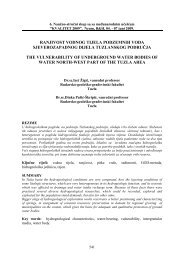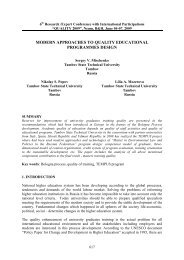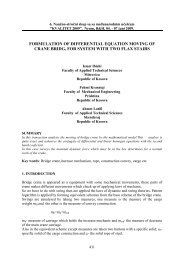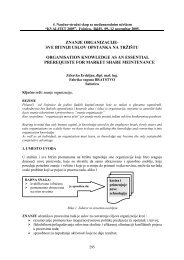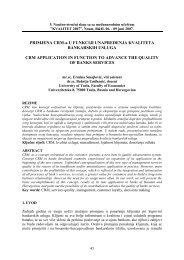regarding the appreciation end evaluation of the machine-tools for ...
regarding the appreciation end evaluation of the machine-tools for ...
regarding the appreciation end evaluation of the machine-tools for ...
Create successful ePaper yourself
Turn your PDF publications into a flip-book with our unique Google optimized e-Paper software.
4 th Research/Expert Conference with International Participations<br />
”QUALITY” 2005, Fojnica, B&H, November 09 - 12, 2005.<br />
REGARDING THE APPRECIATION END EVALUATION OF THE<br />
MACHINE-TOOLS FOR WOOD PROCESSING THROUGH THE<br />
QUALITY CRITERIA<br />
Nicolae TARAN, Sergiu RACASAN, Nicoleta GODAN<br />
TRANSILVANIA University <strong>of</strong> Brasov, Romania<br />
Keywords: <strong>machine</strong>, quality, <strong>evaluation</strong><br />
ABSTRACT<br />
The <strong>machine</strong>-<strong>tools</strong> <strong>for</strong> wood-processing present several particularities compared to o<strong>the</strong>r fields. On <strong>the</strong><br />
o<strong>the</strong>r hand <strong>the</strong> display <strong>of</strong> such <strong>machine</strong>s is large and diverse, which impose <strong>the</strong> existence <strong>of</strong> some common<br />
<strong>appreciation</strong> and <strong>evaluation</strong> criteria.The paper refers to <strong>the</strong> importance <strong>of</strong> quality connected to <strong>the</strong><br />
purchase price <strong>of</strong> <strong>the</strong> <strong>machine</strong>, <strong>the</strong> <strong>appreciation</strong> and <strong>evaluation</strong> possibilities, special emphasis being put<br />
on <strong>the</strong> quality <strong>of</strong> <strong>the</strong> <strong>machine</strong>s, on <strong>the</strong> technical and exploiting characteristics.The <strong>appreciation</strong>s and<br />
considerations belong to <strong>the</strong> authors, taking into consideration <strong>the</strong> concrete production conditions in <strong>the</strong><br />
Romanian companies.<br />
1. INTRODUCTION<br />
The wood processing in Romania has a long presence and experience. This industrial branch<br />
takes an important place in <strong>the</strong> general modern development <strong>of</strong> <strong>the</strong> country, both <strong>regarding</strong><br />
<strong>the</strong> finite product as well as <strong>the</strong> labor hand.<br />
The structure <strong>of</strong> <strong>the</strong> companies has gone through a radical change in <strong>the</strong> field <strong>of</strong> <strong>the</strong> woodproduct<br />
diversity and technical <strong>end</strong>owment. The modernization <strong>of</strong> <strong>the</strong> wood-industry takes an<br />
accelerated rhythm using per<strong>for</strong>mant <strong>machine</strong>-<strong>tools</strong>, units and equipment, which guarantee<br />
<strong>the</strong> production <strong>of</strong> semi-finished and finished wood-products competitive on national and<br />
international markets.<br />
We take as guarantee that a well chosen technical <strong>end</strong>owment constitutes <strong>the</strong> link between all<br />
<strong>the</strong> parts <strong>of</strong> a production technology (fig.1). [6,7]<br />
Following this scheme, having <strong>the</strong> parts <strong>of</strong> <strong>the</strong> production process in a closed circuit, <strong>the</strong><br />
technical <strong>end</strong>owment is revealed through <strong>the</strong> quality <strong>of</strong> <strong>the</strong> <strong>machine</strong>s, but also through <strong>the</strong>ir<br />
exploitation conditions based on <strong>the</strong>ir technical characteristics. All <strong>the</strong> parts are in close<br />
connection with <strong>the</strong> production process and determine <strong>the</strong>ir quality.<br />
The paper presents <strong>the</strong> <strong>machine</strong>-<strong>tools</strong> <strong>of</strong>fer, <strong>the</strong> <strong>appreciation</strong> and <strong>evaluation</strong><br />
possibilities, <strong>the</strong> quality <strong>of</strong> <strong>the</strong> <strong>machine</strong>s and <strong>the</strong>ir technical and exploiting<br />
characteristics being emphasized.<br />
The opinions and <strong>the</strong> <strong>appreciation</strong>s <strong>of</strong> <strong>the</strong> authors are conventional and orientative, based on<br />
<strong>the</strong> concrete conditions <strong>of</strong> <strong>the</strong> Romanian companies.<br />
441
Figure 1.<br />
2. THE MACHINE-TOOLS OFFER IN THE WOOD PROCESSING INDUSTRY IS<br />
RICH AND DIVERSE SATISFYING ALL THE NEEDS AND STANDARDS OF THE<br />
WOOD PRODUCTS MANUFACTURERS.<br />
In this situation <strong>the</strong> companies are placed in a challenging situation, “bombarded” with <strong>the</strong><br />
most varied and per<strong>for</strong>mant <strong>machine</strong>-<strong>tools</strong> <strong>of</strong> high quality and flexibility.<br />
Figure 2.<br />
Three main questions have to be taken into consideration, when acquiring <strong>machine</strong>-<strong>tools</strong>:<br />
When to chose? What to chose? How to chose? Only by answering <strong>the</strong>se questions, one can<br />
get <strong>the</strong> necessary in<strong>for</strong>mation and one can take <strong>the</strong> most convenient <strong>of</strong>fer [6,10].<br />
The decision <strong>for</strong> <strong>the</strong> best quality and economic <strong>of</strong>fer requires a good understanding <strong>of</strong> each<br />
<strong>machine</strong> but also a good knowledge <strong>of</strong> <strong>the</strong> exact needs <strong>of</strong> <strong>the</strong> company.<br />
442
Regardless <strong>the</strong> size <strong>of</strong> <strong>the</strong> company, <strong>the</strong>y should be able to obtain <strong>the</strong> necessary in<strong>for</strong>mation,<br />
classificated into five categories <strong>of</strong> questions, according to fig.3 [2,3,6].<br />
3. QUALITY CONDITIONS OF THE MACHINE-TOOLS<br />
The aquirecing <strong>of</strong> a <strong>machine</strong>-tool should be based on certain quality conditions. The<br />
<strong>evaluation</strong> <strong>of</strong> <strong>the</strong> quality can’t be made at first sight. It must result from <strong>the</strong> sum <strong>of</strong> all <strong>the</strong><br />
characteristics <strong>of</strong>fered by <strong>the</strong> producer and <strong>the</strong> technological demands <strong>of</strong> <strong>the</strong> beneficiary<br />
(fig.4). Consequently <strong>for</strong> <strong>the</strong> <strong>evaluation</strong> <strong>of</strong> <strong>the</strong> quality <strong>the</strong>re should be a technical<br />
documentation <strong>of</strong> <strong>the</strong> producer using common scientific criteria with <strong>the</strong> beneficiary.<br />
Figure 3. Figure 4.<br />
The quality <strong>of</strong> <strong>the</strong> <strong>machine</strong>-<strong>tools</strong> represents <strong>the</strong> sum <strong>of</strong> <strong>the</strong>ir characteristics, <strong>the</strong> degree in<br />
which<br />
<strong>the</strong>y satisfy, <strong>the</strong> necessities, <strong>the</strong> degree <strong>of</strong> <strong>the</strong>ir utility and economic efficiency.<br />
For a <strong>machine</strong>-tool to satisfy its purchaser, one should take into consideration <strong>the</strong> following<br />
aspects (fig.5): <strong>the</strong> quality <strong>of</strong> its conception, <strong>the</strong> quality <strong>of</strong> its execution and <strong>the</strong> quality <strong>of</strong> its<br />
exploitation [6,7].<br />
These quality aspects are common <strong>for</strong> all <strong>machine</strong>-<strong>tools</strong> in <strong>the</strong> wood industry. They are<br />
indep<strong>end</strong>ent when <strong>the</strong> <strong>appreciation</strong> is made <strong>regarding</strong> efficiency and production. Only by<br />
taking into consideration <strong>the</strong> utility degree, <strong>the</strong> economizing degree and <strong>the</strong> economics <strong>of</strong> <strong>the</strong><br />
<strong>machine</strong>, one can fully appreciate its quality level.<br />
The practical <strong>appreciation</strong> <strong>of</strong> <strong>the</strong> quality should be based on some requirements grouped<br />
according to <strong>the</strong> scheme fig.6 The requirements mentioned completely characterize any<br />
<strong>machine</strong>-<strong>tools</strong> if <strong>the</strong> necessary in<strong>for</strong>mation is available.<br />
443
Figure 5.<br />
Distinction should be made between <strong>the</strong> building requirements shown in <strong>the</strong> “production<br />
characteristics” and <strong>the</strong> exploitation requirements shown in <strong>the</strong> “usage characteristics”. The<br />
two types <strong>of</strong> requirements are completed by <strong>the</strong> “social characteristics” common <strong>for</strong> both<br />
types.<br />
In taking <strong>the</strong> purchase decision one should start from <strong>the</strong> production characteristics specific<br />
to each producer. Among <strong>the</strong> eight characteristics mentioned in fig.6, reliability is <strong>the</strong> most<br />
important [5,6]. This should be mentioned because <strong>the</strong> behavior <strong>of</strong> a <strong>machine</strong>-tool during<br />
exploitation dep<strong>end</strong>s both on <strong>the</strong> initial characteristic and <strong>the</strong> way it preserves itself during<br />
exploitation. Reliability is <strong>the</strong> safest and most complex criterium <strong>for</strong> <strong>the</strong> quality <strong>appreciation</strong><br />
<strong>of</strong> a <strong>machine</strong>-tool.<br />
444
Figure 6.<br />
The usage characteristics are particularly important in appreciating quality and evaluating <strong>the</strong><br />
<strong>of</strong>fers. Among <strong>the</strong> eight mentioned in fig.6 availability is extremely important. The <strong>machine</strong>tool<br />
can fulfill its duty that is, it can be available if it is reliable and if it is maintainable.<br />
Flexibility or mobility <strong>of</strong> <strong>the</strong> <strong>machine</strong>-<strong>tools</strong> is also important. It shows its capacity to swift<br />
from one process to ano<strong>the</strong>r in identical or close conditions <strong>of</strong> usage without essential<br />
modifications.<br />
Quality considerations can not be completed without <strong>the</strong> social characteristics witch refer<br />
both to those <strong>of</strong>fered by <strong>the</strong> <strong>machine</strong> but also to <strong>the</strong>ir influence to <strong>the</strong>ir operator. Actually,<br />
social characteristics should be making <strong>the</strong> link between man and <strong>machine</strong>. Among <strong>the</strong> four<br />
characteristics presented in fig.6 <strong>the</strong> es<strong>the</strong>tic ones should be subordinated to <strong>the</strong> usage<br />
conditions. Form and color should be taken into consideration [1,6].<br />
The <strong>for</strong>m should be harmonious, unitary, compact and stable, it should be easily handled by<br />
man. Color is important <strong>for</strong> its es<strong>the</strong>tics and <strong>for</strong> its influence on he psychological state <strong>of</strong> <strong>the</strong><br />
worker.<br />
To summarize, <strong>the</strong> <strong>appreciation</strong> <strong>of</strong> <strong>the</strong> quality <strong>of</strong> <strong>the</strong> <strong>machine</strong>-tool through <strong>the</strong> presented<br />
criteria should not be omitted in analyzing any <strong>of</strong>fer, as <strong>the</strong>y will positively or negatively<br />
influence <strong>the</strong> quantity, <strong>the</strong> quality and <strong>the</strong> efficiency <strong>of</strong> <strong>the</strong> results <strong>of</strong> <strong>the</strong> company.<br />
4. SEVERAL APPRECIATION AND EVALUATION OF THE MACHINE-TOOLS.<br />
Several <strong>appreciation</strong> and <strong>evaluation</strong> <strong>of</strong> <strong>the</strong> <strong>machine</strong>-<strong>tools</strong> can be made according to <strong>the</strong><br />
following criteria [2,6]:<br />
• According to configuration and shape taking into consideration <strong>the</strong> conception and <strong>the</strong><br />
construction <strong>of</strong> <strong>the</strong> <strong>machine</strong>-tool to grant <strong>the</strong>m a high technical level.<br />
445
• According to structure, complexity and componencies which determine <strong>the</strong> type and<br />
<strong>the</strong> model <strong>of</strong> <strong>the</strong> <strong>machine</strong> <strong>for</strong> a certain need or function mentioned in <strong>the</strong> <strong>of</strong>fer.<br />
• According to <strong>the</strong> usage field, aiming that <strong>the</strong> <strong>machine</strong> should efficiency integrate in<br />
<strong>the</strong> technological process.<br />
Machines should be evaluated based on a data-bank. Regardless <strong>the</strong> size <strong>of</strong> <strong>the</strong> company, this<br />
should get all <strong>the</strong> necessary in<strong>for</strong>mation grouped in five categories <strong>of</strong> questions [2,6]. It is<br />
essential to settle <strong>the</strong> requirement <strong>for</strong> <strong>the</strong> <strong>machine</strong>, than one should concentrate on <strong>the</strong> type <strong>of</strong><br />
<strong>the</strong> <strong>machine</strong>-tool which will best satisfy <strong>the</strong> technological needs.<br />
The <strong>appreciation</strong> <strong>of</strong> a <strong>machine</strong>-tool is correct only if it is made based on <strong>the</strong> documentation<br />
and in<strong>for</strong>mation. This can also be sustained through value elements used in <strong>the</strong> conception<br />
and design <strong>of</strong> <strong>the</strong> <strong>machine</strong>s. One can use in this respect <strong>the</strong> recomm<strong>end</strong>ation VDI – Directive<br />
2225 (Technisch – wirtschaftliches Konstruieren) [2,3,6]. This recomm<strong>end</strong>ation makes <strong>the</strong><br />
difference between a “technical value x” and an “economical value y” which result a “power<br />
s” <strong>of</strong> <strong>the</strong> <strong>machine</strong>s. The “economic value y” refers to <strong>the</strong> production costs, but <strong>the</strong> purchaser<br />
is interested in <strong>the</strong> purchasing and usage costs.<br />
Orientatively, <strong>the</strong> <strong>machine</strong> can be appreciated from a technical and economical point <strong>of</strong><br />
view. The economic <strong>appreciation</strong> will contain only <strong>the</strong> production costs and <strong>the</strong><br />
purchase. According to <strong>the</strong> VDI – Directive 2225 <strong>the</strong> <strong>appreciation</strong> degree runs on a<br />
scale between 0 and 4.<br />
When purchasing a <strong>machine</strong>, <strong>the</strong> purchasing price is relevant. It contains <strong>the</strong> price itself, but<br />
also <strong>the</strong> costs <strong>for</strong> packing, transport, assembling and starting and interests. The technical<br />
recomm<strong>end</strong>ation VDI – Directive 2225 establishes <strong>the</strong> link x-y which limit <strong>the</strong> areas<br />
“satisfactory and unsatisfactory” <strong>for</strong> <strong>the</strong> values x and y [1,2,3].<br />
5. CONCLUSIONS<br />
Taking into consideration <strong>the</strong> above mentioned, <strong>the</strong> authors <strong>for</strong>mulated <strong>the</strong> following<br />
conclusions:<br />
• The technical <strong>end</strong>owment <strong>of</strong> a company guarantees quality finish products<br />
competitive on <strong>the</strong> international market.<br />
• The quality <strong>appreciation</strong> <strong>of</strong> a company can be made only through <strong>the</strong> level <strong>of</strong> its<br />
technical <strong>end</strong>owment.<br />
• The quality <strong>appreciation</strong> and <strong>the</strong> <strong>evaluation</strong> <strong>of</strong> <strong>the</strong> <strong>machine</strong>-<strong>tools</strong> should be based on<br />
well-chosen scientific criteria, shaped <strong>for</strong> all bidders.<br />
• There should be complete data-bank <strong>for</strong> each <strong>machine</strong>-tool.<br />
• The <strong>evaluation</strong> and <strong>appreciation</strong> should contain all in<strong>for</strong>mation <strong>regarding</strong> <strong>the</strong><br />
technological possibilities <strong>of</strong> <strong>the</strong> <strong>machine</strong>-tool, <strong>the</strong> flexibility and adaptability <strong>for</strong><br />
certain collateral operations.<br />
• The establishing <strong>of</strong> <strong>the</strong> quality is not complete if not taken into consideration <strong>the</strong><br />
exploiting conditions <strong>of</strong> <strong>the</strong> <strong>machine</strong>-<strong>tools</strong> <strong>the</strong> safety degree <strong>of</strong> <strong>the</strong> <strong>machine</strong> but also<br />
<strong>of</strong> <strong>the</strong> operator.<br />
• The practical application <strong>of</strong> <strong>the</strong>se recomm<strong>end</strong>ations will assure <strong>the</strong> best choice and<br />
efficiency <strong>of</strong> <strong>the</strong> <strong>machine</strong>-tool.<br />
• These considerations, mentionings, and <strong>appreciation</strong>s belong to <strong>the</strong> authors, <strong>the</strong>y have<br />
an orientative and optional character in usage and in practical application.<br />
446
6. REFERENCES<br />
[1] Ispas, C., ş.a. - Ergonomia maşinilor-unelte, Editura Tehnică, Bucureşti, 1984.<br />
[2] Maier Gerhard - Holzberabeitungsmaschinen, DRV – Verlag Stuttgart, 1987.<br />
[3] Maier Gerhard – Anleitungen und Anw<strong>end</strong>ungbeispiele zur metodischen Vorgehensweise bei<br />
Beschaffung und Einsatz von Maschinen in der Holzwitschaft – Verlag Weinbrenner GmbH &<br />
Co, Leinfelden Echterdingen, 1993.<br />
[4] Militaru, C. – Fiabilitatea şi precizia în tehnologia construcţiilor de maşini, Editura Tehnică,<br />
Bucureşti, 1987.<br />
[5] Oprean, A., ş.a. – Fiabilitatea maşinilor-unelte, Editura Tehnică, Bucureşti, 1979.<br />
[6] Ţăran Nicolae, - Maşini-unelte şi utilaje pentru prelucrarea mecanică a lemnului, Editura<br />
Universităţii “TRANSILVANIA”, Braşov, 2004.<br />
[7] Ţăran Nicolae, - Exploatarea maşinilor-unelte şi utilajelor din industria lemnului, Editura<br />
Universităţii “TRANSILVANIA” din Braşov, 2005.<br />
[8] Ţăran Nicolae, - Dotarea tehnică a societăţilor comerciale condiţia principală pentru fabricarea<br />
produselor de calitate din lemn, Revista INDUSTRIA LEMNULUI – Mileniul III, nr. 1,<br />
Bucureşti, 2005.<br />
[9] Ţăran N, Beganu N, - General conditions Regarding <strong>the</strong> ratio between <strong>the</strong> technology and <strong>the</strong><br />
technical <strong>end</strong>owment in <strong>the</strong> fabrication proces <strong>of</strong> finished wooden products - Proceedings WOOD<br />
SCIENCE AND ENGINEERING IN THE THRID MILENIUM, Transilvania University <strong>of</strong><br />
Braşov, November, 2002.<br />
[10] Ţăran Nicolae, - On <strong>the</strong> decisional act concerning <strong>the</strong> selection <strong>of</strong> <strong>machine</strong> <strong>tools</strong> and equipment<br />
in <strong>the</strong> wood product industry - Procedings (2), 14 th Internationl Wood machining seminar,<br />
September 12 - 19; 1999 Epinal – Franţa.<br />
447
448



